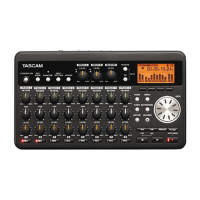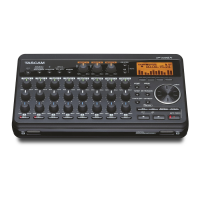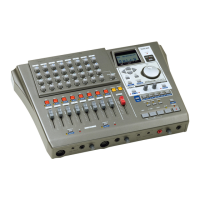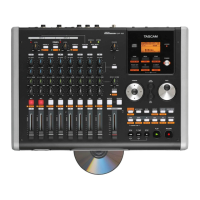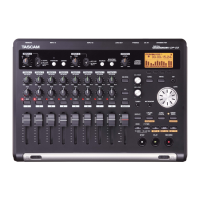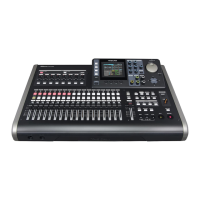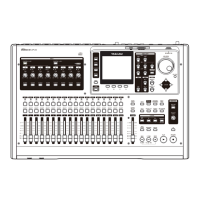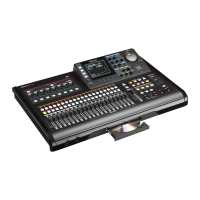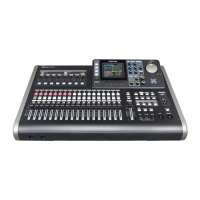Do you have a question about the Tascam DP-006 and is the answer not in the manual?
FCC and Canadian compliance statements for digital devices.
Disposal guidelines for electrical equipment and batteries in Europe.
Precautions for handling and using batteries to prevent leaks or rupture.
Information on hazardous substances in product parts for China.
Key features of the DP-006 and a list of items included in the package.
Explains manual formatting, symbols, and lists trademarks.
Info on SD cards, installation precautions, condensation, and cleaning the unit.
Steps for inserting SD card/batteries and starting playback/mixing.
Steps to open Home Screen, Menu, and load/mix the demo song.
Safety cautions for power/SD card and general operational tips.
Introduction to multitrack recording and creating new songs.
Configuring internal mics as inputs and assigning them to tracks.
Steps to set input levels and monitor audio signals.
Guide for recording rhythm guitar using internal microphones.
Steps to play back tracks, connect guitars, and set switches.
Configuring guitar input and recording lead guitar to TRACK 2.
Steps to record vocals and adjust monitoring levels.
Steps to mix down tracks to create a stereo master track.
How to play back and verify the stereo master track.
Procedures for safely shutting down the unit.
Identifies controls and indicators on the top panel.
Identifies front panel components like built-in microphones.
Identifies rear and left side panel connectors and controls.
Identifies right side panel connectors and bottom panel features.
Location of battery compartment and explanation of Home Screen elements.
Lists menu items, their functions, and navigation methods.
Basic operations using function buttons and the DATA wheel.
Procedures for handling SD cards, including insertion, removal, and write-protection.
Details on using AA batteries or the TASCAM PS-P520 AC adapter.
Steps for starting up the unit and performing a proper shutdown.
Guide to formatting SD cards and explanation of recorder modes.
Examples of connecting external devices and diagrams of rear/left panel connections.
Diagram of right side panel connections and how to adjust display contrast.
Explanation of SD card partitions and song data organization.
How to choose an active MTR partition for song operations.
Procedures for editing song titles and loading existing songs.
Steps to create a new song project and save the current song.
How to check song details and copy songs between partitions.
How to delete songs from the SD card to free up space.
How to enable/disable song protection to prevent edits or deletions.
How to choose input sources for INPUT A/B and view available options.
How to monitor input signals and configure monitoring modes.
Explanation of overload indicators and various signal level meters.
How to assign inputs to tracks and set track types for 3/4.
Assigning inputs to stereo tracks 3/4.
Assigning inputs to mono tracks and steps for making the first recording.
Procedures for multitrack recording, setting tracks, levels, and input assignments.
How to monitor/set levels and record additional tracks.
Overview of undo/redo functions, single undo, and redo procedures.
How to perform multi-undo using the operation history.
How to clear the operation history from the unit.
Replacing parts of recorded tracks by punching in/out.
Mixing tracks down to fewer tracks using the bounce function.
Step-by-step guide for using the bounce function.
Adjusting bounce source track levels/pans and confirming results.
Tools for navigating within songs, including direct locate, RTZ/LRP, and search.
How to set IN/OUT points for repeat playback and editing.
Starting, stopping, and setting repeat playback intervals.
Introduction to track editing, functions, and editing points.
General steps for accessing and performing track edits.
Explains track selection options for various editing functions.
How to duplicate a track, track pair, or master track.
How to erase an entire selected track.
How to erase a section of a track between IN/OUT points.
How to delete a part of a track, shortening its length.
How to insert silence into a track, lengthening it.
Adjusting track levels, balance, and stereo positions for a mixdown.
Introduction to mixing down tracks to a stereo master track.
Steps for creating a stereo master track, including adjustments.
How to play back and verify the created stereo master tracks.
How to set up and use the built-in metronome.
How to use the built-in chromatic tuner for guitars or wind instruments.
How to configure auto power saving and restore default settings.
How to view song, card, system, and firmware information.
Explanation of SD card partitioning into MTR and FAT partitions.
Guide to formatting SD cards, including partition setup.
How to reformat specific MTR partitions without changing size.
How to reformat the FAT partition and initialize SD cards.
Compatible OS and types of data transferable: songs, WAV tracks, stereo masters.
Steps for connecting the DP-006 to a computer using a USB cable.
Procedures for safely disconnecting the USB connection from Windows and Mac.
How to backup songs to the FAT partition and restore them.
Procedure for restoring songs from backup files.
Overview of importing and exporting individual tracks.
Steps to import WAV files into tracks from a computer.
How to export tracks as 16-bit, 44.1kHz mono/stereo WAV files.
Steps for selecting tracks and exporting them to the computer.
How to export stereo master tracks to a computer.
Common issues and solutions for not hearing sound during playback.
Common issues and solutions for distorted recording sound.
Common issues and solutions for problems preventing recording.
Troubleshooting computer connection and file access problems.
Troubleshooting noise when using AC adapter with passive guitar/bass.
Meaning and remedy for battery and SD card related messages.
Meaning and remedy for mode, partition, and track related messages.
Meaning and remedy for undo, card, song protection, and track messages.
Meaning and remedy for work memory and SD card error messages.
Details on media, file systems, and input/output connections.
Frequency response, distortion, and S/N ratio specifications.
Supported OS, power, consumption, dimensions, and weight.
Settings retained when OFF, and physical dimensions of the unit.
Schematic representation of the unit's signal flow.
How to format partitions, select active partitions, and initialize SD cards.
How to create, name, copy, delete, and protect songs.
How to set IN/OUT points, clone tracks, and create/export stereo masters.
How to undo/redo operations, and display song name.
How to tune guitar/bass and find partition information.
How to use USB connection and back up songs to PC.
How to delete track sections, insert silence, copy, and export tracks.
How to bounce tracks, format partitions, and restore songs.
Metronome settings, recording time, and using built-in mic.
How to monitor input signals and assign inputs to tracks.
How to playback stereo masters, change repeat interval, and use power saving.
Steps to adjust the display contrast.
FCC and Canadian compliance statements for digital devices.
Disposal guidelines for electrical equipment and batteries in Europe.
Precautions for handling and using batteries to prevent leaks or rupture.
Information on hazardous substances in product parts for China.
Key features of the DP-006 and a list of items included in the package.
Explains manual formatting, symbols, and lists trademarks.
Info on SD cards, installation precautions, condensation, and cleaning the unit.
Steps for inserting SD card/batteries and starting playback/mixing.
Steps to open Home Screen, Menu, and load/mix the demo song.
Safety cautions for power/SD card and general operational tips.
Introduction to multitrack recording and creating new songs.
Configuring internal mics as inputs and assigning them to tracks.
Steps to set input levels and monitor audio signals.
Guide for recording rhythm guitar using internal microphones.
Steps to play back tracks, connect guitars, and set switches.
Configuring guitar input and recording lead guitar to TRACK 2.
Steps to record vocals and adjust monitoring levels.
Steps to mix down tracks to create a stereo master track.
How to play back and verify the stereo master track.
Procedures for safely shutting down the unit.
Identifies controls and indicators on the top panel.
Identifies front panel components like built-in microphones.
Identifies rear and left side panel connectors and controls.
Identifies right side panel connectors and bottom panel features.
Location of battery compartment and explanation of Home Screen elements.
Lists menu items, their functions, and navigation methods.
Basic operations using function buttons and the DATA wheel.
Procedures for handling SD cards, including insertion, removal, and write-protection.
Details on using AA batteries or the TASCAM PS-P520 AC adapter.
Steps for starting up the unit and performing a proper shutdown.
Guide to formatting SD cards and explanation of recorder modes.
Examples of connecting external devices and diagrams of rear/left panel connections.
Diagram of right side panel connections and how to adjust display contrast.
Explanation of SD card partitions and song data organization.
How to choose an active MTR partition for song operations.
Procedures for editing song titles and loading existing songs.
Steps to create a new song project and save the current song.
How to check song details and copy songs between partitions.
How to delete songs from the SD card to free up space.
How to enable/disable song protection to prevent edits or deletions.
How to choose input sources for INPUT A/B and view available options.
How to monitor input signals and configure monitoring modes.
Explanation of overload indicators and various signal level meters.
How to assign inputs to tracks and set track types for 3/4.
Assigning inputs to stereo tracks 3/4.
Assigning inputs to mono tracks and steps for making the first recording.
Procedures for multitrack recording, setting tracks, levels, and input assignments.
How to monitor/set levels and record additional tracks.
Overview of undo/redo functions, single undo, and redo procedures.
How to perform multi-undo using the operation history.
How to clear the operation history from the unit.
Replacing parts of recorded tracks by punching in/out.
Mixing tracks down to fewer tracks using the bounce function.
Step-by-step guide for using the bounce function.
Adjusting bounce source track levels/pans and confirming results.
Tools for navigating within songs, including direct locate, RTZ/LRP, and search.
How to set IN/OUT points for repeat playback and editing.
Starting, stopping, and setting repeat playback intervals.
Introduction to track editing, functions, and editing points.
General steps for accessing and performing track edits.
Explains track selection options for various editing functions.
How to duplicate a track, track pair, or master track.
How to erase an entire selected track.
How to erase a section of a track between IN/OUT points.
How to delete a part of a track, shortening its length.
How to insert silence into a track, lengthening it.
Adjusting track levels, balance, and stereo positions for a mixdown.
Introduction to mixing down tracks to a stereo master track.
Steps for creating a stereo master track, including adjustments.
How to play back and verify the created stereo master tracks.
How to set up and use the built-in metronome.
How to use the built-in chromatic tuner for guitars or wind instruments.
How to configure auto power saving and restore default settings.
How to view song, card, system, and firmware information.
Explanation of SD card partitioning into MTR and FAT partitions.
Guide to formatting SD cards, including partition setup.
How to reformat specific MTR partitions without changing size.
How to reformat the FAT partition and initialize SD cards.
Compatible OS and types of data transferable: songs, WAV tracks, stereo masters.
Steps for connecting the DP-006 to a computer using a USB cable.
Procedures for safely disconnecting the USB connection from Windows and Mac.
How to backup songs to the FAT partition and restore them.
Procedure for restoring songs from backup files.
Overview of importing and exporting individual tracks.
Steps to import WAV files into tracks from a computer.
How to export tracks as 16-bit, 44.1kHz mono/stereo WAV files.
Steps for selecting tracks and exporting them to the computer.
How to export stereo master tracks to a computer.
Common issues and solutions for not hearing sound during playback.
Common issues and solutions for distorted recording sound.
Common issues and solutions for problems preventing recording.
Troubleshooting computer connection and file access problems.
Troubleshooting noise when using AC adapter with passive guitar/bass.
Meaning and remedy for battery and SD card related messages.
Meaning and remedy for mode, partition, and track related messages.
Meaning and remedy for undo, card, song protection, and track messages.
Meaning and remedy for work memory and SD card error messages.
Details on media, file systems, and input/output connections.
Frequency response, distortion, and S/N ratio specifications.
Supported OS, power, consumption, dimensions, and weight.
Settings retained when OFF, and physical dimensions of the unit.
Schematic representation of the unit's signal flow.
How to format partitions, select active partitions, and initialize SD cards.
How to create, name, copy, delete, and protect songs.
How to set IN/OUT points, clone tracks, and create/export stereo masters.
How to undo/redo operations, and display song name.
How to tune guitar/bass and find partition information.
How to use USB connection and back up songs to PC.
How to delete track sections, insert silence, copy, and export tracks.
How to bounce tracks, format partitions, and restore songs.
Metronome settings, recording time, and using built-in mic.
How to monitor input signals and assign inputs to tracks.
How to playback stereo masters, change repeat interval, and use power saving.
Steps to adjust the display contrast.
| Signal-to-Noise Ratio (SNR) | 81 dB |
|---|---|
| Total Harmonic Distortion (THD) | 0.05 % |
| Frequency range | 20 - 20000 Hz |
| Interface | 3.5mm |
| USB 2.0 ports quantity | 1 |
| Product color | Black |
| Compatible operating systems | Windows XP, Windows Vista, Windows 7, Windows 8, \\r Mac OS X Jaguar (V10.2), Mac OS X Panther (V10.3), Mac OS X Tiger (V10.4), Mac OS X Leopard (V10.5), Mac OS X Snow Leopard(V10.6.8), OS X Lion(V10.7), OS X Mountain Lion(V10.8) |
| USB powered | Yes |
| Weight | 360 g |
|---|---|
| Dimensions (WxDxH) | 155 x 107 x 41.5 mm |
